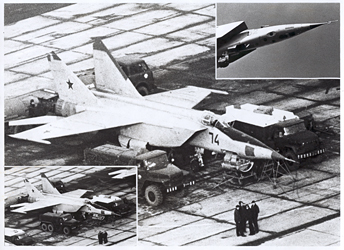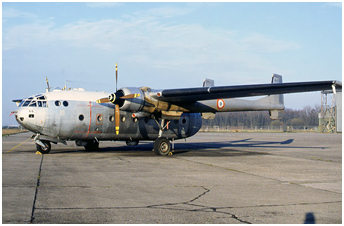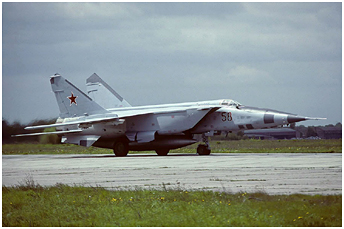Patrick Pallot was an airborne flying Technical Analyst (ELINT) aboard a Nord Gabriel. He recalls for us a an interesting and important Cold War anecdote highlighting the MiG-25s from Werneuchen and the former French COMINT site at Tegel.
 During the early summer of 1978, the MiG-25 pilots of the 931.OGvRAP encountered radio interference during the final approach phase of
the return flight to their home base at Werneuchen. It was precisely at that moment that the pilot transmitted via data link (depending on the MiG-25 version)
the informations collected during their reconnaissance mission to the ground-based processing and interpreting station.
The case caused a stir because the highest authorities thought that it was untimely deceptive jamming. The pilot could not communicate by voice normally anymore with the control
tower during that important navigation phase because he heard in his headphones his own transmission shifted by a few milliseconds.
Disturbed, he could not send properly his orders to the ground processing station before sending the data collected during the mission.
On the other hand, the ground controller could hear the pilot normally and did not notice any interference. That was a mystery!
The different Allied military liaison missions, the British (BRIXMIS), the French (MMFL) and the US (USMLM), as well as the Soviet (1)
were on alert. They swept the West-Berlin enclave and its surroundings in vain, looking for the troublemaker.
One can easily imagine the mutual accusations of aggression, intrusion, acts of piracy, etc... Yet, a jammer emits and, if it emits, it can
be seen on a scope, DF'd and localized... Everybody was cogitating in his corner.
During the early summer of 1978, the MiG-25 pilots of the 931.OGvRAP encountered radio interference during the final approach phase of
the return flight to their home base at Werneuchen. It was precisely at that moment that the pilot transmitted via data link (depending on the MiG-25 version)
the informations collected during their reconnaissance mission to the ground-based processing and interpreting station.
The case caused a stir because the highest authorities thought that it was untimely deceptive jamming. The pilot could not communicate by voice normally anymore with the control
tower during that important navigation phase because he heard in his headphones his own transmission shifted by a few milliseconds.
Disturbed, he could not send properly his orders to the ground processing station before sending the data collected during the mission.
On the other hand, the ground controller could hear the pilot normally and did not notice any interference. That was a mystery!
The different Allied military liaison missions, the British (BRIXMIS), the French (MMFL) and the US (USMLM), as well as the Soviet (1)
were on alert. They swept the West-Berlin enclave and its surroundings in vain, looking for the troublemaker.
One can easily imagine the mutual accusations of aggression, intrusion, acts of piracy, etc... Yet, a jammer emits and, if it emits, it can
be seen on a scope, DF'd and localized... Everybody was cogitating in his corner.
 A decision was taken at the FATac (2)
headquarters:
A decision was taken at the FATac (2)
headquarters:
- ...send them la Grise, ...well, a Comel (3)!
No sooner said than done. The leaders motivated their subordinates... It was necessary to clear this matter up!
- Let's launch a RE3 (4), but we need
Chibanis (5)! Let's wait that Neuneuch (6)
take off and send them an aircraft.
The mission was launched and the Gabriel was in flight before, during and after the flying program at Werneuchen. However, the onboard receivers picked up only the
usual activity.
- It's a shame; what about the Zélintes (7), what are they doing?
The operators at the Berlin electronic detachment [Détachement Electronique 32] at Tegel were hustled, harassed and interrogated, but nothing came from their
screens. Yet, they were monitoring the activities every time! New equipment was operational at Tegel, a very efficient gear... That is what was said after
tests aboard N2501 and the first flights aboard DC8; and the system designer was no less enthusiastic.
We did not understand why we could not intercept that damned transmission... And suddenly, by St. Gabriel, the miracle occurred
thanks to a young NCO somewhat (but, not much!) intellectual, both feet dangling on his cloud and his
head in the stars, while talking with a fellow mechanic who was working on the Furet (radar emissions receiver and analyzer) program
that had just been installed at the station, replacing the old Smyrne dating back to the 1950s:
The rookie said:
- I don't understand. When the intercom announces "a MiG-25 heading 015", I am there...
and I receive nothing other than its navigational radar.
And the linguist at the other end added:
- But it is once again jammed. You really aren't getting anything?
And the rookie said:
- Well no. I have nothing...
And he added:
- You see, the other day the intercom brayed: two MiG-25, heading 018, and you won't believe me, I did not move [the antenna]
and the other said: it's OK, ditch it, there is no interference...
And there, the mechanic said excitedly:
- Damn, that's for sure, I think I understand what is going on!
 He rushed downstairs, arrived at the workshop, talked with his chief, asked the permission to the civil engineer, took one or two
Allen keys and a screwdriver from the bench and headed for the antenna pylon. He emerged 25 meters above the platform
and went inside the fiberglass dome that protected the antennas from the bad weather.
Meanwhile, the news flooded the operation center like a tsunami and a cohort of engineers of all ranks and specialities
invaded the ELINT room, where everyone allowed themselves to comment. When the telephone of the local network rang,
everyone gazed at each other.
He rushed downstairs, arrived at the workshop, talked with his chief, asked the permission to the civil engineer, took one or two
Allen keys and a screwdriver from the bench and headed for the antenna pylon. He emerged 25 meters above the platform
and went inside the fiberglass dome that protected the antennas from the bad weather.
Meanwhile, the news flooded the operation center like a tsunami and a cohort of engineers of all ranks and specialities
invaded the ELINT room, where everyone allowed themselves to comment. When the telephone of the local network rang,
everyone gazed at each other.
Mechanic: - Aim your antenna between 015 and 020
Operator: - It's done!
The young operator who had not yet understand everything, had turned its antenna in the required direction...
 Mechanic: - Allo? What is going on down there?
Mechanic: - Allo? What is going on down there?
The operator: - Neuneuch is still working
The linguist annouced through the intercom: - Two IP (8)
approaching, heading 016
Operator: - Yes, I have got their radars and you, nothing?
Linguist: - No, nothing. They don't report interference...
Operator to mechanic: - How about that! What have you done?
Mechanic: - So, it was correct. OK that's good, I come down and I'll tell you!
The explanation was simple. An antenna, which had been tested with a few degrees negative site on an airplane, had been mounted
inverted in its cradle with a positive site on the antenna mast. When the operator turned the antenna in the
direction of a signal, the reflector was perfectly aligned for a few seconds with the antenna on
the aircraft coming back to Werneuchen. The pilot then received back its own emission with a slight delay.
Nobody knew anything, well almost... and complaints faded away.
That story was extracted from the book "Les avions de Renseignement Electronique - 50 ans d'activités secrètes racontées par les acteurs" - Témoignages recueillis par le Comité Historique de l'Association Guerelec - éditions Lavauzelle, 2009.
notes
(1) The three Soviet military liaison missions known in the West as SOXMIS, the counterparts of the
three Allied military liaison missions operating in
the GDR, were active exclusively in the FRG
inside the former British, French and US occupation zones. The West-Berlin occupation zones were
not governed by the multilateral agreements. Another organization was
consequently concerned in this particular case. It was probably the Soviet
External Relations Bureau (SERB) in Potsdam, GDR, which was the official link between the
Allied missions and the Soviet High Command in East
Germany.
(2) FATac: Force Aérienne Tactique (Tactical Air Force).
(3) Grise: or Grey in English - general nickname of the different versions of the Nord 2501 Noratlas.
Comel: Communications Electroniques. Generic name of the missions flown by the Nord Gabriel.
(4) The Gabriel conducted three types of missions:
- RE1: along the inter-German border.
- RE2: along the Czechoslovak border.
- RE3: inside the Berlin air corridors (N, S or C for North, South or Center) up to the BCZ and Berlin-Tegel airbase.
That type of mission took the name Baltique when the aircraft left Tegel to fly through the north
corridor and joined the Baltic Sea for a mission up
to the Polish border, before returning to the home base at Metz via Tegel.
(5) Chibani: original Arabic term literally meaning "white hair" that designates, in French military slang,
a highly qualified military individual.
(6) Werneuchen.
(7) ELINT, Electronic Intelligence.
(8) IP: Indicatif Pilote or call sign. Each pilot had his own call sign.
"IP heading 016" meant that the operator tasked to monitor to the radio traffic received a broadcast from the 016 compared to his position.
The HF operator correlated this information with the track he received while the ELINT operator received emissions that could come among others
from navigational aids, onboard radar or a data link.
 |
Plan du site - Sitemap |  |
